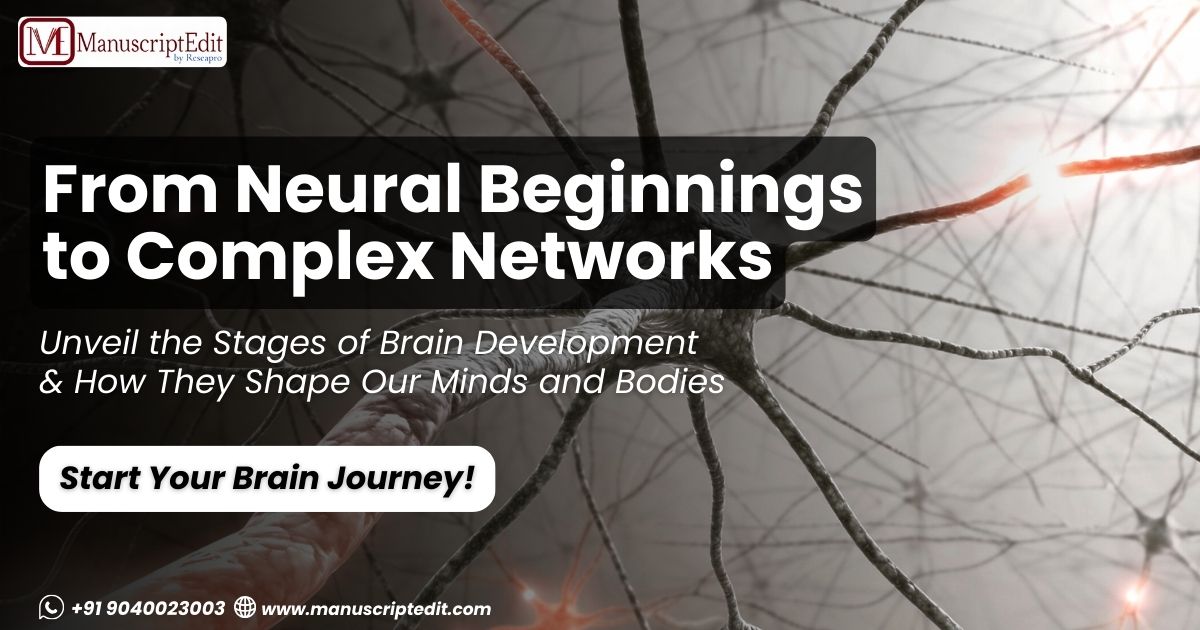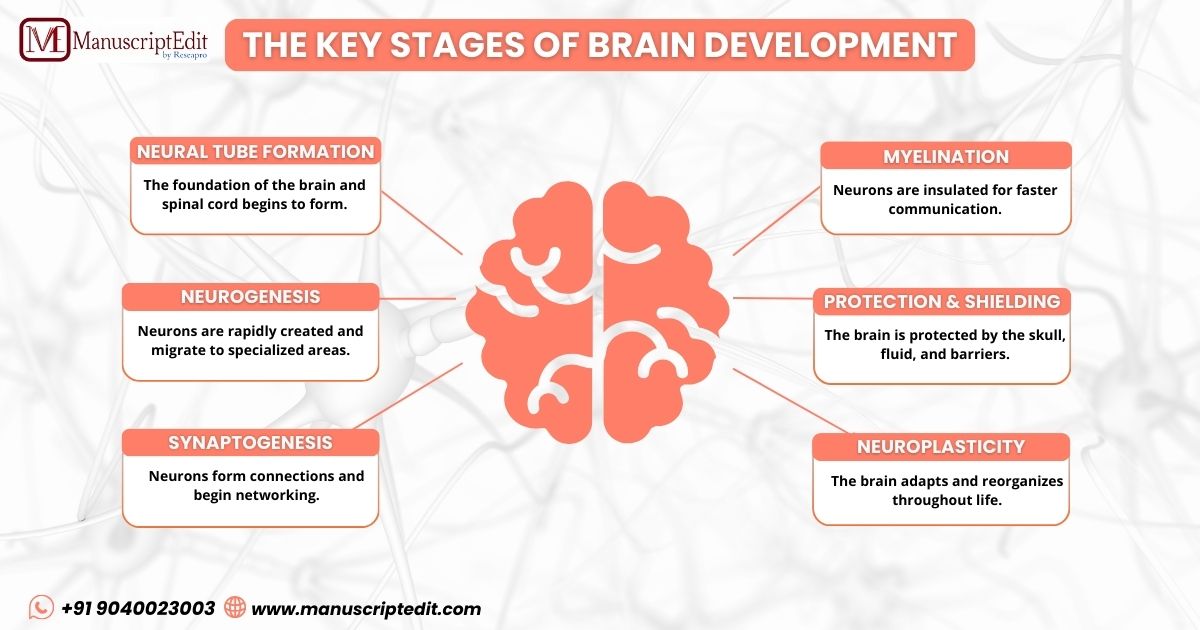|
Getting your Trinity Audio player ready...
|

Do you ever stop to reflect on how impressively your brain can juggle tasks such as remembering your PIN and solving complex equations like Einstein? The brain and nervous system are nothing short of miraculous, but how does this intricate system develop? Is there a little magic in this, or is it merely a pattern of biological events that gives rise to the wonder of thought, sensation, and movement?
As neuroscientists, biomedical researchers, or in any field related to neurobiology, the path that the CNS takes from a handful of cells to being a fully functional, complex network is a treasure trove of biological intricacy and innovation. Let’s embark on an in-depth exploration of the stages of neural development, covering everything from how your brain and spinal cord form to how they’re protected from damage. In this reading, we will pepper some excitement in the discourse too, so let’s dive in.
As a research scholar, delving into the complexities of neural development is more than just academic curiosity—it’s an opportunity to contribute to groundbreaking insights that can influence science and medicine. At Manuscriptedit, we’re here to support you at every step of your research journey, ensuring your findings reach the world’s leading journals.
The Nervous System: An Overview for the Intellectually Curious
Before getting into the developmental intricacies, let’s quickly refresh what the nervous system consists of, because, well, it’s always good to start at the beginning. The nervous system is a highly organized network that controls and coordinates the body’s activities. It consists of:
1. CNS: The brain and the spinal cord are two great heavyweights of the system. The high-order activity of cognition, memory, and sense processing takes place within the brain. The spinal cord is like an important conduit along which signals have to pass between the brain and the rest of the body.
2. The Peripheral Nervous System (PNS): All nerves extending from the CNS to the rest of the body are part of it. The PNS is like a Wi-Fi connection, bringing any kind of message from the brain to every nook and corner of the body, whether it is a muscle flex or a touch feel.
3. The Autonomic Nervous System (ANS): Part of the PNS, the ANS controls the autonomic functions such as heart rate, digestion, and respiratory rate so that the body works properly without conscious thought. Thank goodness!
Well, in simple words, your nervous system is a complex communication infrastructure that keeps the body in check by continuously adjusting and responding to internal and external stimuli.
Step 1: The Emergence of the Nervous System – Neural Tube Formation
Brain and spinal cord development begins early at the embryonic stage-when a little mass of cells begins to differentiate into the components that will form the central nervous system.
Around days 18 to 20, folding of the neural plate begins and forms a hollow structure called the neural tube. At this time, there is no recognizable brain and spinal cord. The neural tube, therefore, represents the skeleton of the CNS, with the closure marking the beginning of neural development.
Why is it important that the neural tube closes completely? If it doesn’t, it can cause severe congenital birth defects: either spina bifida or anencephaly. In other words, the neural tube is the foundation on which everything else will grow. During these earliest stages of development, neural differentiation begins; and the basic structure of the brainstem, forebrain, and hindbrain becomes evident.
This is basically the “blueprint” phase of the nervous system—a set of instructions that will soon guide the growth of neurons, synapses, and axons. The neural tube becomes the future CN—where all the brainy magic will happen. But the fun is just beginning.
For researchers, understanding neural tube formation is crucial. It’s not just about grasping the biological basics but also about exploring interventions that could prevent congenital disorders. Need help polishing your study for publication? Manuscriptedit’s editing services ensure your work aligns with the highest academic standards.
Step 2: Neurogenesis – The Creation of Brain Cells
Once the neural tube is established, the next major event is neurogenesis. This is when things get really cool (and yes, this is the part where you can impress your colleagues with impressive lingo at your next seminar).
Neurogenesis is the formation of the fundamental units of the brain and nervous system. New neurons shoot out at lightning speed during the first few months of embryonic development. For example, in a human embryo that happens approximately 250,000 neurons per minute. That is right, your brain was seriously growing at warp speed from day one.
The neurons are produced within the neural tube and start to migrate to certain parts of the brain, where they will differentiate and specialize in different functions. For example, neurons which are going to migrate into the motor cortex will specialize in controlling movement; those which are destined for the sensory cortex will process sensory input such as touch, sound, and vision.
By the end of this stage, the neural architecture of the brain begins to take shape. Neurons start to clump together and begin forming synapses—connections that allow one neuron to communicate with another. And that is important because synapses provide the foundation for learning, memory, and thinking. The more synapses, the more connections the brain can make. It’s like building a high-speed internet network for your brain, but instead of downloading movies, it’s downloading the intricate functions of your mind.
By the end of this stage, the basic architecture of the brain takes shape. This phase is critical for scholars investigating developmental disorders or neural plasticity. Your discoveries could redefine how we understand brain development. Share your insights with the global research community with our publication support services tailored for high-impact journals.
Step 3: Synaptogenesis and Pruning – The Brain Gets Social
The next major process in brain development is called synaptogenesis, the formation of synapses or connections between neurons. That’s when the brain really gets connected. It’s sort of the “Who’s Who” of high-powered networking, where every neuron is handing out business cards to its friends.
At first, the brain overproduces synapses-more than it actually needs. This is kind of like inviting 200 people to your birthday party and hoping that maybe 30 will show up. The synaptic pruning of your brain, though, is where it wipes out the weak or redundant connections and strengthens the best connections. It’s all about “use it or lose it,” as synapses that are relatively frequently activated from learning and experience will be kept while the rest are pruned away.
Synaptic pruning is what makes the brain more efficient. It’s decluttering your office space for efficiency purposes: instead of clearing out a drawer, your brain is clearing out unused neural pathways. This is especially important in children and adolescents as the brain cleans its structure into place.
Step 4: Myelination – Insulating for Speed and Efficiency
Imagine trying to send a signal across a bunch of uninsulated wires. Signals would move slowly, get lost, and arrive garbled, right? That’s basically what myelination prevents from happening.
Myelination involves the axons of neurons being coated with myelin, a fatty substance. This serves the purpose of insulation around electrical wires. It allows electrical signals to travel more quickly and efficiently. Myelin is necessary for higher cognitive functions, motor coordination, and overall brain performance by speeding up communication between neurons.
Myelination begins early, but continues throughout childhood and even into the early 20s. It progresses upward from the spinal cord to the brainstem, then to the cerebellum, and finally to the cerebral cortex. The prefrontal cortex, governing areas such as decision-making and impulse control in addition to higher cognitive processes, is one of the last to be fully myelinated, hence teenagers occasionally seem a bit. well, impulsive.
Step 5: Protecting the Brain and Spinal Cord – Fortified and Shielded
Okay, so now that we know how the brain develops, let’s take a look at how it’s protected. After all, brain protection is a big deal when you’re dealing with something as precious as cognition and control.
1. The Skull and Spine: The skull is the brain’s first defense. It forms a tough, bony covering that shields the inside from trauma. The vertebrae protect the spinal cord in the spine. This is the most important highway of communication between the brain and the rest of the body.
2. Cerebrospinal Fluid (CSF): Surrounding the brain and spinal cord is cerebrospinal fluid, which provides cushioning and protection. It helps absorb shocks and maintains a stable environment for the brain.
3. Blood-Brain Barrier: Your brain is pretty picky about what enters its sacred domain. The blood-brain barrier regulates the movement of nutrients and filters out unhealthy, including toxins or pathogens, from reaching your brain while nutritionally important substances like glucose and oxygen are allowed inside. Just imagine it as having VIP security at the front gate to your brain: only the important stuff gets in.
4. Meninges: The brain and spinal cord are also covered with three layers of meninges—the dura mater, arachnoid mater, and pia mater. These further cushions the brain, protecting it from any form of harm.

Conclusion: The Complexity of Brain Development and Nervous System Protection
The maturation of the brain and nervous system is an extremely complex process, starting relatively early in embryonic life and continuing throughout adult life. From the formation of the earliest structures of the neural tube to the final stages of myelination and synaptic pruning, but each step counts to sculpt the fully operating nervous system we count on every day. And throughout it all, your brain is being tenderly protected by mechanisms such as the blood-brain barrier, cerebrospinal fluid, and the cranium; making sure that this amazing organ stays safe and efficient.
As you study the development and function of the brain, remember that the human brain remains a work in progress. It is adaptive and keeps changing shape in response to experience, environment, and even injury. Therefore, while we have learned a lot, there is still much to learn. And the next time you are told that you use only 10 percent of your brain, smile and say, “Actually, I think it’s more like 100 percent. just not sure what did I had for breakfast this morning.
If you’re exploring the intricate journey of brain development and nervous system protection in your research, Manuscriptedit is here to support you. Our expert editing and publication services ensure that your groundbreaking work reaches the right audience with clarity and precision.
Have questions or need assistance with your manuscript?
Call Now On: +91-904-002-3003 (IN) for Best Offer Publication Packages. Lets discuss how we can help you publish your research in leading journals!



